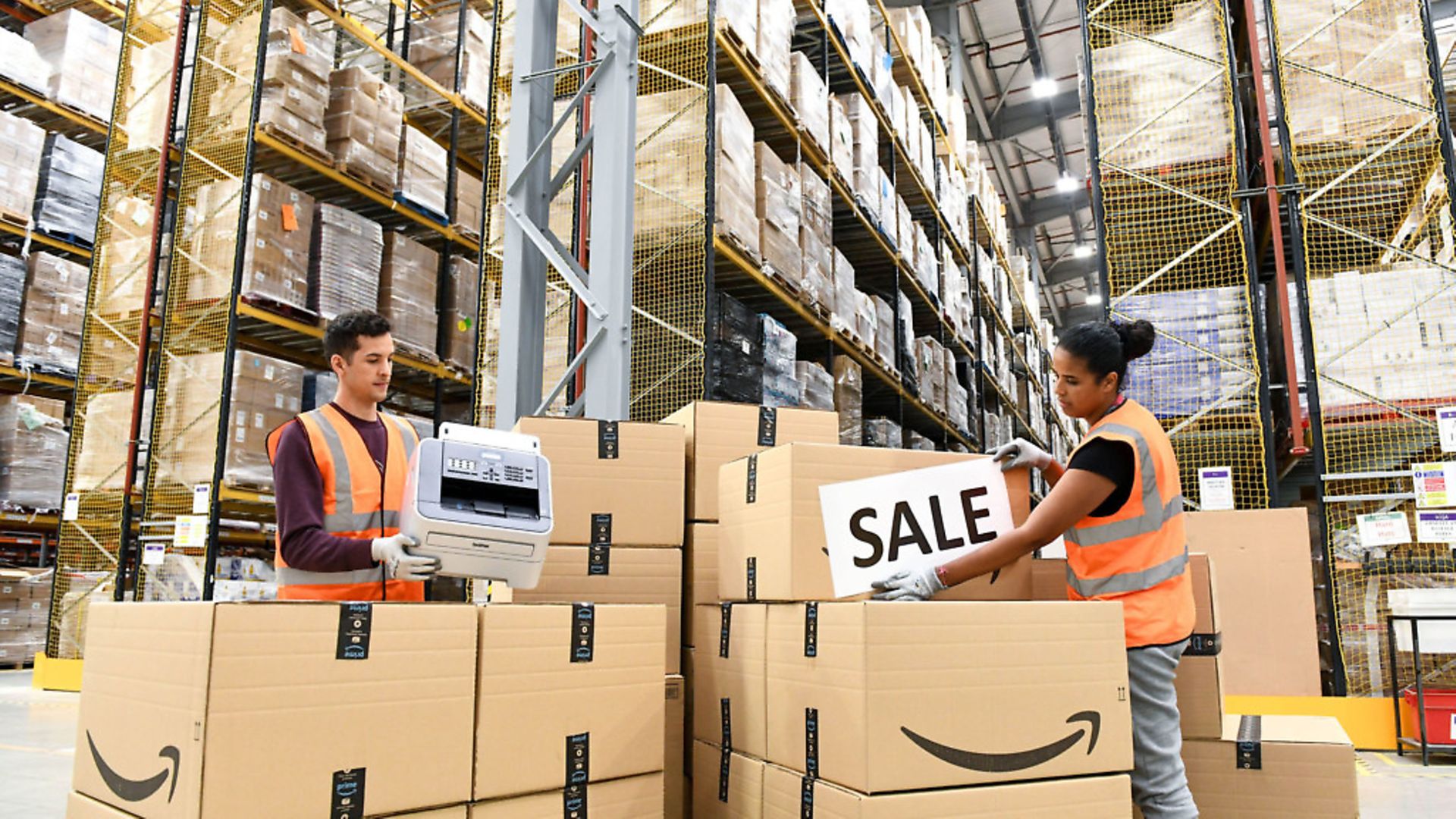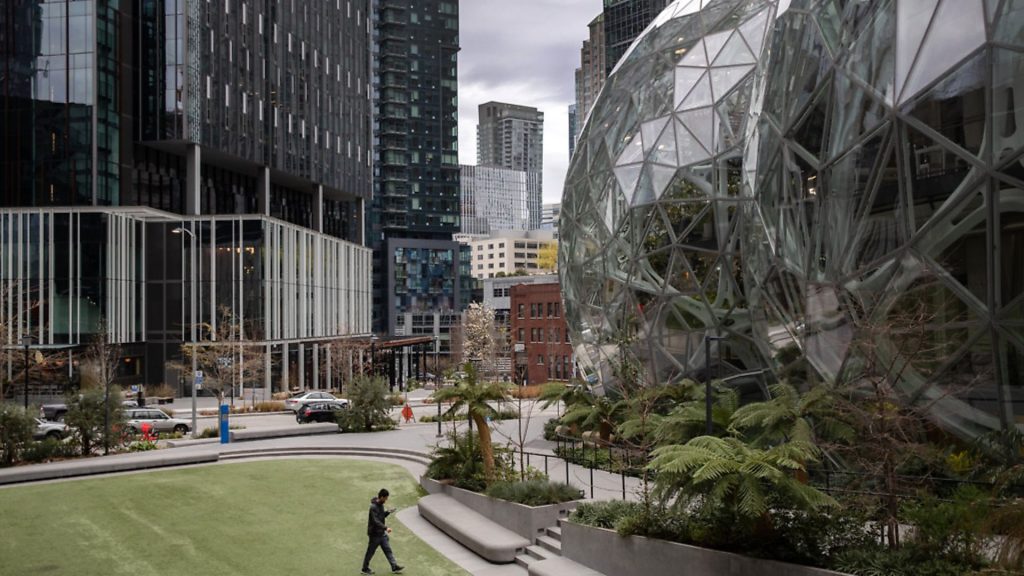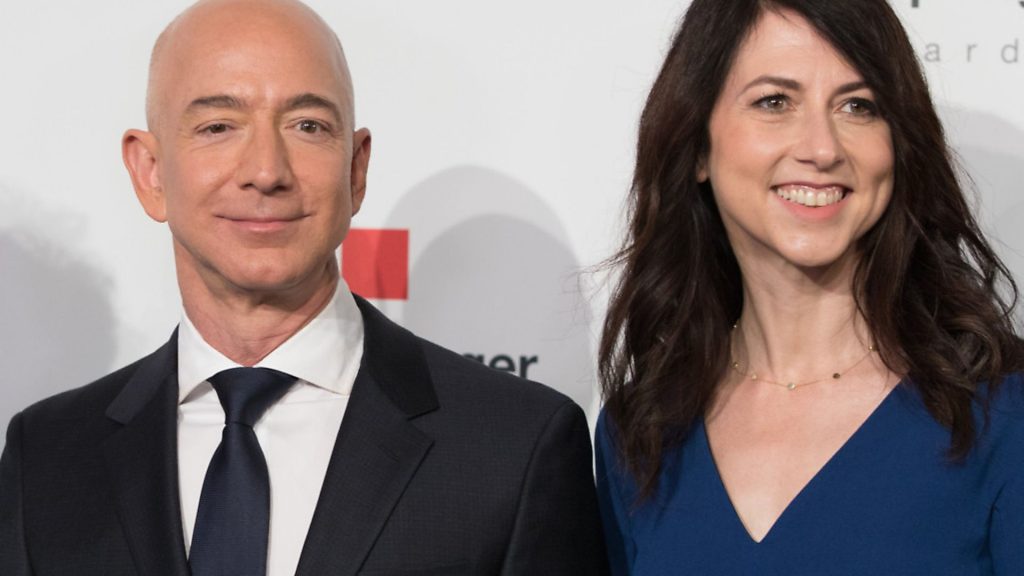
Amazon already has as much power as nation states and its influence has only grown in the pandemic. In a special report, ALEXI MOSTROUS and JAMES BALL examine the leadership and culture of this global superpower.

Tim Bray renounced his Amazon citizenship on May 1. The software executive had been a shining light at the company for more than five years – one of only about 20 ‘distinguished engineers’ at the $1.2 trillion e-commerce giant.
So his accusation that Amazon had fired warehouse whistleblowers with legitimate safety concerns set off a bomb inside a company that had always put a middle finger up to anyone who questioned it. Executives are told not to discuss problems outside the company and follow the 14 leadership principles laid down by its founder, Jeff Bezos, as if they were talmudic texts (Rule number 1: obsess over customers; Rule 3: prepare to be misunderstood).
Bray’s problem with Amazon wasn’t that it had lost focus. By 2023 analysts expect it to worth upwards of $2 trillion. A single division, a profit-generating powerhouse called AWS, is on track to be worth $1 trillion in its own right.
More than 150 million of us now pay Amazon $119 per year to join its Prime Membership programme, which brings faster delivery and a host of other benefits. The average spend of each of those members? $1,400 a year.

But numbers don’t quite capture the connection between Amazon and its customers. We have come to rely on – and even love – those brown boxes with the logo resembling a smiley face. To be able to click a button and see almost any product appear on your doorstep within 24 hours feels less like commerce, and more like magic.
Since the pandemic shuttered shops around the world, our dependency has only increased. In the first three months of 2020, Amazon collected $33 million in sales every single hour of the day. We’re not in a casual relationship with Jeff Bezos any more. We’re going steady.
No. Bray hadn’t quit in spite of Amazon’s success, but because of it.
‘Amazon has been striving monomaniacally for greater efficiency and velocity for what, 25 years?’ he tells us, in one of his only interviews since he left. ‘They have a huge range of products, good prices and fast delivery. How could anybody be against that?
‘They can only do that by having a disempowered workforce. That kind of goodness is not free. At some point, the cost has to be counted.’
Bray had come to the heart of Amazon’s paradox. Here was a company in middle age that was still behaving like an adolescent. Amazon had retained the culture of start-up despite growing into the world’s largest online retailer – a phenomenal achievement and the driving force behind its success in so many varied sectors.
But this very relentlessness has become part of its problem. Like a camera narrowly focused on a single point, its field of vision has become blurred. Amazon’s laser-like commitment to customers generates real human costs – for employees, for governments, for the environment. For the most part, its leaders have failed to acknowledge a corporate responsibility to anyone apart from the consumer.
‘Amazon has been heard to say ‘We’re willing to be misunderstood’,’ Bray said, quoting the third Amazonian leadership principle. ‘That’s such bulls**t. It means, ‘we’re smarter than you. We know what you’re doing. You just don’t get it’.
‘When you are the largest, most powerful company in the world, it’s not OK to be misunderstood any more.’
Even by the standards of the other tech giants, Amazon stands apart. It’s bigger by market capitalisation ($1.2 trillion), by the number of individual customers (at least 300 million), by the number of companies it counts as clients. Its logo has, depending on how you see it, a swoosh or a smile that goes from A to Z. And, increasingly, it does everything. At a time when America’s influence is receding in the world, Amazon’s writ runs further and deeper across the planet. The Pax Americana may be waning, but the Amazon Platform reaches further. And like the US in its heyday, Amazon is a commercial empire that has come to do good – and done much more besides.
Bray – who otherwise found working for Amazon ‘tremendous fun’ – had held his nose for years about the tough conditions at its 175 fulfilment centres. At these warehouses, free painkillers are handed out to help with the stress of standing and lifting for 10 hours a day; workers are expected to pack at a rate of up to 700 items per hour, and underperforming employees are written up not by a manager, but by a computer algorithm.
Bray snapped – as he puts it – when Amazon started firing warehouse employees who spoke out about safety during the first weeks of the Covid-19 pandemic in March. Sacking whistleblowers wasn’t intrinsic to the function of a free market, he thought, but rather, as he wrote in a scathing note published on his blog, ‘evidence of a vein of toxicity running through the company culture’.
One of those fired workers, Chris Smalls, told us that Amazon had played down the dangers of Covid-19 to warehouse workers in early-to-mid-March. ‘We had no PPE, no facial masks, we were not protected at all,’ he said. ‘Amazon doesn’t give a damn about people.’ (Amazon denies firing Smalls or any other worker for talking publicly about safety. It alleges he and other individuals violated other policies such as breaching social distancing guidelines).
Some would say that the vein of toxicity identified by Bray does not stop with the treatment of workers.
Bezos, who spent $47m building a mechanical clock designed to run for 10,000 years in the bowels of his West Texas ranch, has given relatively little of his wealth away – at least when compared to other multi-billionaires like Bill Gates. It took 3,500 Amazon employees to sign a letter last April urging their boss to adopt a climate change policy for him to pledge to go carbon neutral by 2040.
Amazon has also been criticised for aggressively minimising tax, paying $162m to the US government in 2019 after two straight years of handing over precisely $0 (this year Amazon reported $276m in state tax payments as well as an international tax bill of more than $1.1 billion).
In Seattle, its hometown, Amazon fiercely opposed a 2018 tax hike on large employers that would have raised $48m a year to combat the city’s homelessness crisis, which is the third worst in the United States. Instead of paying $13m a year, Amazon joined other conglomerates to fund a non-profit lobbying group called No Tax on Jobs. After a sustained campaign, the tax was repealed. ‘The opposition has unlimited resources,’ Lisa Herbold, a council member, noted drily.
‘Amazon grew up as an entrepreneurial organisation, and being told they weren’t going to succeed, and having to fight for everything, and they still have that underdog mindset,’ John Rossman, a former exec – at the company until 2005 – told us. ‘I think they’ve got to understand their role is completely different. They’re great about thinking about the customers, and they’re amazing thinking about the shareholder, but there is this now third element, what’s called just… society.’
Culture is an important word at Amazon. From the moment an employee steps through one of its complex of 40 high-rise buildings in Seattle that makes up its headquarters, it’s obvious they could not be working anywhere else.
There’s no carpet to soften their shoe fall: too expensive. Unlike Apple, which filled its headquarters with $14,000 Poltrona Frau chairs, Amazon employees work on desks made from reclaimed doors. Business cards are printed in black and white. There is no free food (apart from coffee and bananas).
‘Even in these billion dollar high-rises they use graffiti murals that they’ve taken from abandoned houses,’ one Amazon executive who left in the last three years told us. ‘They believe frugality engenders creativeness.’
So famous is Amazon’s penny-pinching that it features in a jokey Amazon-English dictionary hosted on the company’s internal systems. Frupid means ‘so frugal it’s stupid’. Other entries include ‘Promoted to Customer’ (translation: someone got fired) and ‘Biased for Chaos’ (a negative play on Amazon’s third leadership principle, biased for action).
‘The organisation that Amazon reminds me the most of is the Marines,’ the former executive told us. ‘When you look at the Marine Corps, the idea is to keep teams small and fast-moving. They make decisions based on the 80% rule – if there’s an 80% chance of everybody living – do it.’
Amazon is not a place where being the cleverest gets traction – it’s about results. Executives are encouraged to ‘disagree, but commit’ once a decision is made. Arguments should be set out in documents, meetings are for decisions, and managers are encouraged to solve problems themselves rather than pass them up the chain. The environment is austere and analytical; polite but not warm.
Employees even have a nickname for this Amazonian chilliness: ‘Seattle Freeze’.
Like the Marine Corps, Amazon is an extremely hierarchical organisation. Everyone is grouped into 12 grades, with an entry level floor-worker being Grade 1 and Bezos being 12.
‘To make things more complicated, there’s no nine,’ Bray explained, speaking via video-link from the porch of his West Coast home. ‘Nobody knows why. Your level matters really a lot. It is a fairly hierarchical company. People want to find out what your level is before they know how seriously to take what you say.’
How seriously should we take Bray, then? ‘I was a level 10,’ he says with a laugh. Things have changed, though: I’m an unemployed bum now.’
There are 22 people on the levels above Bray who run Amazon’s disparate divisions, and together they make up the ‘S-Team’, which leads the organisation.
Many run empires larger than most FTSE 100 companies. Andy Jassy, the CEO of Amazon Web Services (AWS), runs a $40bn revenue high-margin company with tens of thousands employees – and has been with Amazon since 1997.
Dave Clark, senior vice president of worldwide operations, is in charge of 750,000 or more logistics workers across the planet. Jay Carney, who handles corporate affairs, is best known as president Barack Obama’s former press secretary.
Others head an ad division which is now the world’s third-largest (excluding China), AI research through Alexa, the creating of devices such as Kindle, and numerous other businesses.
In the company’s early days, Bezos introduced a ‘two pizza’ rule for meetings: any meeting where two pizzas would not be enough to feed the whole group shouldn’t take place, he said. Nothing would get decided.
Bezos could, perhaps, just about still feed his top team with two pizzas – provided no-one was very hungry. But former Amazon executives say it would be wrong to think of the company as ruled by meeting and committee.
‘That team of 22, that team is primarily there to think about, what’s the future? What are the big bets that we’re going to make?’ said Rossman, the former executive who has also written the 2019 book Think Like Amazon: 50 1/2 Ideas to Become a Digital Leader.
The rhythm of the week for leaders at the company, then and now, he says was metrics meetings: what’s working, what isn’t, and what’s being done about it? These trump all else, he adds, as part of a ‘relentless’ focus on delivering for customers. In fact, Relentless.com was the first domain name Bezos registered when planning his new business. To this day, it still points to amazon.com – a reminder of the ethos that delivery matters.
‘I was recently talking to an Amazon product owner, and he was like, ‘The things we’re allowed to miss on are like new features or launches. We don’t want to, but what we can’t miss on is our metrics’,’ says Rossman. ‘Trying to deliver perfection today is part of that relentless mandate.’
Bezos might not be at his desk quite so often as before – his Blue Origin space operation has consumed more of his time, alongside side projects and investments including the 10,000-year clock and ownership of the Washington Post newspaper – but it doesn’t mean no-one is paying attention.
‘It’s not just Jeff that can yank the chain of a team or an organisation and get a response,’ Rossman says. ‘Essentially, anybody with a VP title at Amazon carries a big stick.’
Like the former executive, Rossman also compared Amazon to the Marine Corps. ‘It’s a process of being accepted, but then weeding out, right? It’s the same thing at Amazon. It’s demanding. They expect excellence, and they expect excellence in many different facets. It’s not for everybody.’
Given its tough culture, you might expect Amazon to have a high rate of turnover in its leadership as people seek a quieter life. Tech executives, unlike some of the warehouse workers they employ, have no shortage of other well-paid jobs they can pursue – and yet generally they don’t.
‘That S-team has been remarkably consistent,’ says Mark Mahaney, a managing director covering the internet sector research at RBC Capital Markets. ‘I’m down in the Bay Area, and it’s rare to see senior management teams stay as consistent as what you have at Amazon.
‘Jeff Wilke [CEO of global consumer], Andy Jassy have been there for a long time. I know a couple of these people pretty well… They clearly have very good executives who stay together as a team for quite a long period of time.’
The consensus among those who know the team is that their longevity is linked to the extraordinary free rein they are given to run their teams at Amazon. Bezos, they say, isn’t like other tech founders, who insist on micromanaging their companies. Bezos has set up a culture and leaves the leaders in his business to the rest.
‘You get a degree of freedom, as a senior person, to get things done that you might not get in a lot of other organisations. It’s diverse work, and you’re both operating today, but you’re getting to build in the future,’ says Rossman.
‘There’s not many places you can go to work where you get the degree of freedom and the vision of keep building, keep expanding, that Jeff and the board at Amazon have created.’
That freedom and that aggression is one thing when you’re the scrappy upstart, celebrating in 1997 that your inventory of books has now hit 200,000 titles. It is something quite different when you’re one of the world’s biggest companies, responsible directly or indirectly for more than four million jobs, many of them insecure and low-paid.
Insiders report the coronavirus crisis has made Bezos far more hands-on at Amazon again, now that there are new problems for the company to solve, and new situations to adapt to – but one day he will move on. Few who know the company expect that to change how it operates, though. The culture Bezos has built will last, at least for a while.
‘They may lose some steps, but they won’t lose any strides, were Bezos to step down,’ says Mahaney. ‘Amazon has codified all these practices time and time again, is it’s way beyond Jeff Bezos,’ Rossman concurs.
‘If Jeff got run over by a bus tomorrow, what is it? Today is Wednesday,’ Bray wonders aloud. ‘If Jeff got run over by a bus this afternoon, they’d have a new CEO announced by the end of the day.’
This article was originally published by Tortoise. Tortosie is committed to open, inclusive journalism and helping its members make sense of the world around them. Try it today. Download the Tortoise app and you can get your first 30 days for free.









